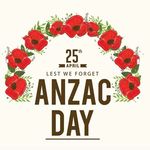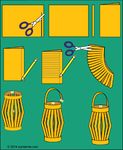Living through History Worksheet - Lesson Nine Copyright National Army Museum Te Mata Toa 1 - National ...
←
→
Page content transcription
If your browser does not render page correctly, please read the page content below
He waka eke noa
We are all in this together
The experiences of the soldiers’ as they landed, dug in, and fought at Gallipoli
created the bond between Australia and New Zealand that we remember every year.
History isn’t something that happens to someone else. Right now, you are living through a very
unusual event that is changing the New Zealand way of life: the COVID-19 pandemic. Future
children might look back at this moment and ask: how did they feel? How did they make it
through?
We can ask the same thing about another generation of Kiwis who lived through unusual times:
the New Zealanders who went to the other side of the world to fight in World War 1
(1914 - 1918).
Then, like now, a major global crisis forced everyday New Zealanders to think about the way they
were used to living. They didn’t know if the future would be good or bad - but they had hope and
went away to risk their lives for their country.
For each of the following activities:
- Read about the New Zealand experiences at Gallipoli.
- Reflect on how these New Zealanders were feeling.
- Respond to the questions or activities at the end of each activity.
Share your answers with your classmates and teacher. We all look at things differently so it is
interesting to see how we feel.
Living through History Worksheet - Lesson Nine Copyright National Army Museum Te Mata Toa 2Activity 1: Where and when is Anzac Day held?
Many soldiers from all over the world were sent to fight in a war. It was known as the Great War,
and later, World War 1. New Zealand and Australian soldiers were sent to Gallipoli to capture a
piece of land that would give ships a way to get supplies through to Russia.
- What they didn’t know was how fiercely the soldiers of the Ottoman Empire (modern
day Turkey) would fight to stop them!
- What they didn’t know was that there were mines in that strip of water.
- What they didn’t know was their ships had drifted during the night and they were sent
ashore to the WRONG beach!
On April 25th, 1915, the Australian and New Zealand troops were sent ashore to attack the Turkish
soldiers and get to the highest point of the peninsular - Chanuk Bair. If they could get up there they
would be able to keep the Narrows (a very thin piece of sea) open for ships.
Many men were killed before they had even reached the beach. Others had to dig, dig, dig, to get
away from the bullets that were coming down on them from the cliffs and make themselves safe.
1a Make a diorama of a ship floating off the beach. Use a shoe box or any other small box to
make your model in. You could also use Lego or other building blocks. Don’t forget to put an
interesting background picture at the back of the box. Look at the example to help you.
1b Find a New Zealand, Australian, and Turkish flag. Choose one and copy and colour it.
1c What is a mine that would be in the water? What does it look like? How does it work?
Living through History Worksheet - Lesson Nine Copyright National Army Museum Te Mata Toa 3Activity 2: What is Anzac Day?
Why do we celebrate it?
A sprig of rosemary
Anzac Day is a day that New Zealanders and
Australians remember their fallen soldiers in all
wars around the world. It started accidently! The
original order of poppies to be sold in New
Zealand was late arriving here. They were
supposed to be here for Armistice Day in 1920,
(November 11th) but the ship from England was
late. The poppies were to be sold to raise funds
to support returned soldiers and their families.
Rather than wait until the next November 11th,
the decision was made to sell them during the
week leading up to the 25th of April - one of New Zealand’s most memorable days in WW! Usually
soldiers wore sprigs of rosemary for remembrance.
We celebrate Anzac Day to remember!
2a Make a poppy. You can use this design or make up one of your own. Take a photo when you
have finished and share it with your teacher.
2b Soldiers wrote letters and sent postcards home to their families and friends. Design and make
a postcard. Write a short message to someone you haven’t been able to see for ages because
you are stuck in your bubble. Tell them how you are feeling and what you want to do when you are
allowed out again.
Living through History Worksheet - Lesson Nine Copyright National Army Museum Te Mata Toa 4Activity 3: Why do we use the poppy? In Europe many soldiers fought in a place called the Western Front. It was a line that went from the North Sea to Switzerland on the French border. The German soldiers were trying to push through into France. The allied forces - Great Britain, Ireland, France, Australia, New Zealand, India, Italy, NewFoundland, Canada, United States, and Russia - fought along this line. In the winter it was wet, muddy, cold, and sometimes frozen. Life in the trenches was horrible. Because of all of the bombs and soldiers stirring up the dirt and the mud, many poppies started to flower in a place called Flanders. This was an area where many soldiers had died and were buried. A Canadian doctor wrote a poem for his friend who had been killed and the poppies were part of his inspiration. This is why the poppy is used as a symbol of remembrance. 3a Make a paper lantern using red paper or decorate paper with poppies, then make the lantern. Take a photo of it to share with your teacher and friends. 3b Using the bottom half of a clean plastic milk bottle, decorate with poppy designs using sharpies or vivid marker pens. Put a tealight candle in the carton and light it at dawn on Anzac Day. Living through History Worksheet - Lesson Nine Copyright National Army Museum Te Mata Toa 5
Activity 4: The poppy today Every year in the week before April 25th poppies are for sale, all through New Zealand. On the Friday before Anzac Day there are hundreds of volunteers including past and present soldiers selling poppies around New Zealand. They don’t have a price - they are swapped for a donation. All the money raised goes to the RSA - The Returned and Services Association - to support the families of soldiers who have died in war, and also to support those who came home but may have been injured or cannot work any more. There are many people in New Zealand who knit poppies and send them to us at the National Army Museum, Te Mata Toa, and we have them for sale for a donation all year round. 4a Think of some ideas that you and your classmates could do as a fundraiser for the local RSA. Make a plan, a timeline and share with your class. 4b Talk with your family about Anzac Day. How is it going to be different this year? What stories do your family members have about their parents or grandparents fighting for New Zealand. Ask questions. 4c Make an Anzac Day card to send to another member of your family. Think carefully about what you would like to say to them about being stuck at home and not able to share special times with them. Living through History Worksheet - Lesson Nine Copyright National Army Museum Te Mata Toa 6
Beyond the Worksheet
There are other items that we think about with Anzac Day. One of these is Anzac biscuits. Here is the
recipe from the ‘Food in a Minute’ website. Read it through and, if you have all of the ingredients, see if you
and another family member can make them. Enjoy!
You need:
1 cup rolled oats
1 cup dessicated coconut
1 cup flour
1 cup sugar
125g butter
2 Tbsp golden syrup
1 tsp baking soda
2 Tbsp boiling water
1. Preheat the oven to 180℃. Lightly grease a baking tray or line with baking paper.
2. Combine oats, coconut, flour and sugar in a large bowl.
3. Melt butter and golden syrup together. Dissolve the baking soda in the boiling water and add to the
butter mixture. Pour the butter mixture into the dry ingredients and mix together.
4. Roll teaspoon lots into balls and place on the tray. Leave space for them to spread.
5. Bake for 12-15 minutes, cooking one tray at a time.
Another activity you may like to try is growing
your own poppies from seed. Talk to someone
you know who is a good gardener and ask them
how to do this. Make a list of what you need and
then write the method (just like the recipe for
Anzac biscuits) and have a go. Share your
instructions with other people, especially the
children in your class, and your teacher.
Transplanting Poppy Seedlings
Living through History Worksheet - Lesson Nine Copyright National Army Museum Te Mata Toa 7You can also read



























































